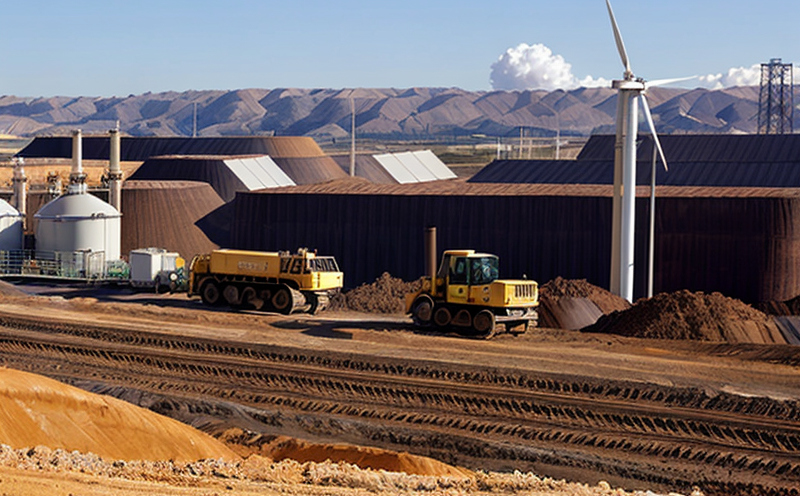ISO 14067 Carbon Footprint of Mining Products Testing
The ISO 14067 standard provides a framework for assessing the carbon footprint of products, which is crucial in the mining sector where resource efficiency and environmental impact are paramount. This service focuses on quantifying the greenhouse gas emissions associated with mining products throughout their life cycle. The process involves detailed lifecycle assessment (LCA) to identify, quantify, and communicate the direct and indirect GHG emissions from raw material extraction through processing, manufacturing, transportation, use, and final disposal.
The service is tailored for quality managers, compliance officers, R&D engineers, and procurement professionals who need accurate data on the carbon footprint of their products. By understanding these emissions, companies can make informed decisions to reduce their environmental impact, comply with regulatory requirements, and enhance their sustainability credentials.
Our team specializes in the following aspects:
- Lifecycle assessment (LCA) methodology
- Data collection from multiple stages of production
- Analyzing raw materials and manufacturing processes
- Transportation and distribution impact analysis
- Economic input-output analysis for resource efficiency
- Compliance with ISO 14067 standards
The testing process involves several steps:
- Data gathering from the supply chain, including suppliers and customers.
- Life cycle inventory (LCI) analysis to determine inputs and outputs.
- Impact assessment using life cycle impact assessment (LCIA).
- Reporting of results in accordance with ISO 14067 guidelines.
The tables below provide a breakdown of the key aspects involved in this service:
| Aspect | Description |
|---|---|
| Data Gathering | Involves collecting information on raw materials, energy consumption, and waste generation. |
| Lifecycle Inventory Analysis | Identifies all inputs and outputs throughout the product lifecycle. |
| Impact Assessment | Evaluates the environmental impacts of these activities using recognized methods. |
| Reporting | Presents findings in a standardized format that is compliant with ISO 14067 standards. |
| Stakeholder Role | Expected Outcome |
|---|---|
| Quality Manager | Improved product sustainability and compliance with environmental regulations. |
| Compliance Officer | Verification of compliance with international standards for carbon footprint reporting. |
| R&D Engineer | Data-driven insights for product innovation and process optimization. |
The ISO 14067 standard is widely recognized as a robust framework for product carbon footprinting. By adhering to this standard, organizations can ensure that their reporting is accurate, transparent, and aligned with global best practices.
Benefits
- Enhanced reputation through transparent environmental performance disclosure.
- Achievement of regulatory compliance.
- Informed decision-making for sustainability initiatives.
- Possibility of cost savings from process improvements and resource efficiency.
- Competitive advantage in the market by demonstrating environmental stewardship.
- Enhanced customer trust and engagement through clear communication of product impact.
The service is designed to meet the specific needs of mining companies that are committed to improving their sustainability practices. By quantifying the carbon footprint, organizations can identify areas for improvement and implement targeted strategies to reduce emissions.
Competitive Advantage and Market Impact
The ability to accurately measure and report the carbon footprint of mining products provides a significant competitive edge in the market. Investors, customers, and regulators are increasingly demanding transparency regarding environmental impact. Companies that can demonstrate leadership in sustainability are more likely to attract investment and secure long-term contracts.
By participating in this service, organizations not only meet regulatory requirements but also contribute positively to global efforts towards reducing carbon emissions. This proactive approach helps build brand loyalty and fosters a positive reputation among stakeholders.
Use Cases and Application Examples
The ISO 14067 carbon footprint testing service is applicable to various scenarios in the mining industry, including:
- Evaluating the environmental impact of new product designs.
- Determining the most efficient production processes.
- Assessing supply chain emissions from raw material extraction to final use.
- Measuring the effectiveness of emission reduction initiatives.
The following case studies illustrate how this service can be applied:
| Company | Description |
|---|---|
| Mining Corp A | Evaluating the carbon footprint of a new iron ore concentrate product. |
| SteelCo | Determining supply chain emissions for a steel production process. |
The use cases demonstrate how this service can help mining companies make informed decisions that lead to reduced environmental impact and improved efficiency.





